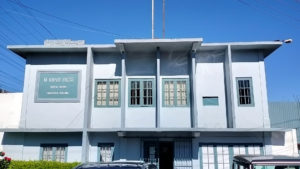 It takes commitment and dedication to be a torchbearer for a progressive society and the indigenous Khasi tribe is fortunate to have produced men like U Babu Jeebon Roy Mairom, known as the “Father of Modern Khasis”, who tirelessly worked towards promoting the Khasi literature, language and way of life through the establishment of a printing press.
It takes commitment and dedication to be a torchbearer for a progressive society and the indigenous Khasi tribe is fortunate to have produced men like U Babu Jeebon Roy Mairom, known as the “Father of Modern Khasis”, who tirelessly worked towards promoting the Khasi literature, language and way of life through the establishment of a printing press.
In this episode of Shillong’s Iconic Structures, allow us to take you on a trip down memory lane as we try to encapsulate the 126-yr-old journey and transformation of the first vernacular press in the Khasi Hills – the Ri Khasi Press, established by Babu Jeebon Roy in 1896.
 Located in the tribal-dominated locality of Umsohsun, a few kilometres away from Iewduh, the Ri Khasi Press is a landmark that serves as a reminder of the advent of literacy in the Khasi and Jaintia Hills.
Located in the tribal-dominated locality of Umsohsun, a few kilometres away from Iewduh, the Ri Khasi Press is a landmark that serves as a reminder of the advent of literacy in the Khasi and Jaintia Hills.
This two-storeyed semi-concrete and semi-wooden structure with a sizeable parking space, a small lawn in the front yard and a park-like surrounding in the backyard, was a home away from home for many aspiring Khasi authors and writers back in the day.
Before we dwell into the architectural and structural aspects of the press, let us first take a look at the mission and vision of the man who contributed immensely towards enriching Khasi literature.
 U Babu Jeebon Roy believed that to educate society, books written in vernacular languages were of
U Babu Jeebon Roy believed that to educate society, books written in vernacular languages were of
When he realised that in the Khasi Hills then, the focus was on publishing Biblical stories and translations of the Bible, he propelled the need to establish a press that would go beyond religion and emphasise on literacy.
In 1896, he wrote a letter to Sir William Erskine Ward, the then Chief Commissioner of undivided Assam, and said, “There are few religious books and pamphlets that have been published…. for primary schools etc. but there are no publications which may serve as general reading for the majority of the people.”
In the same year, the government gave permission and the Ri Khasi Press was born. It was established in the compound of Babu Jeebon Roy’s residence in Umsohsun with his own earnings. The first manager was Chandranath Roy, son of U Babu Jeebon Roy.
 Since its inception till date, Ri Khasi Press has provided Khasi writers with a platform to launch their works. Aside from this, it also provided a platform for writers and readers to learn more about their own country and connect with other communities through the medium of literature.
Since its inception till date, Ri Khasi Press has provided Khasi writers with a platform to launch their works. Aside from this, it also provided a platform for writers and readers to learn more about their own country and connect with other communities through the medium of literature.
The Ri Khasi Press was a busy establishment back in the day. During the period of 1897 to 1901, Babu Jeebon Roy published a wide-ranging variety of books such as Ka Niam jong ki Khasi (1897), Ka Kitab Shaphang Uwei U Blei (1900), The History of India in Khasi language (1901), three Khasi and Bengali primers and translation works of Hitopadesha in 1898, Ramayana and Chaitanya Charitra in 1900 and Buddha Deb Charitra in 1901. His eldest son, Sib Charan Roy translated the Bhagavad Gita from Sanskrit to Khasi.
Apart from Jeebon Roy’s books, many other acclaimed books were also published here like Ka Jingsneng Tymmen, a Khasi book of Ethics and Etiquette, a literary masterpiece by Radhon Singh Berry Kharwanlang published in 1901. It was translated into English by noted author Bijoya Sawian and published in 1997.
Here’s something that might interest you: We are all aware that it was Rev Thomas Jones, a Welsh Christian missionary, who recorded the Khasi language in Roman script. But did you know that it was Babu Jeebon Roy, along with his fellow authors — Rabon Singh Suka and Radhon Singh Berry Kharwanlang who perfected the pronunciation and diction of the language. They dropped the letters c,f,v,x, and z and added “ng, ï, and ñ” to the alphabets.
The Ri Khasi Press was started not only to disseminate knowledge amongst people but also to provide employment to the young illiterate Khasi women who were willing to earn their livelihood.
After the press was set up, Babu Jeebon Roy put his own daughter, Lakheitmon Sawian, to work in the press to encourage other women to come forward as in those days, it was said that Khasi women were ashamed to seek employment.
The printing press is still functioning as a printing press and a publishing house using the latest technology. Apart from general printing, the Press still prints school magazines, songbooks, research papers, and journals both private and government and others.
(Watch the full version of the story only on our YouTube Channel @TheShillongTimes)



